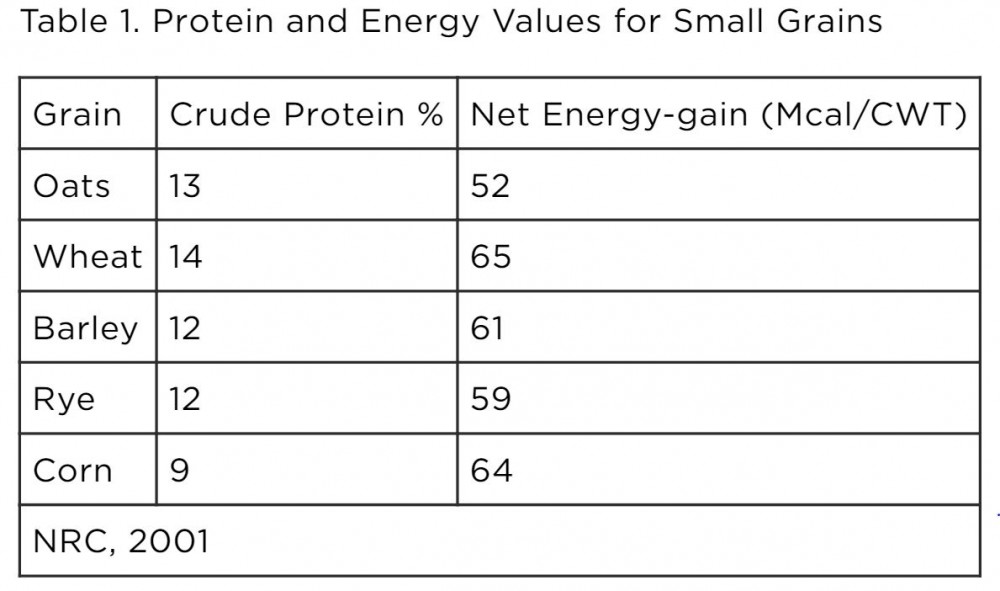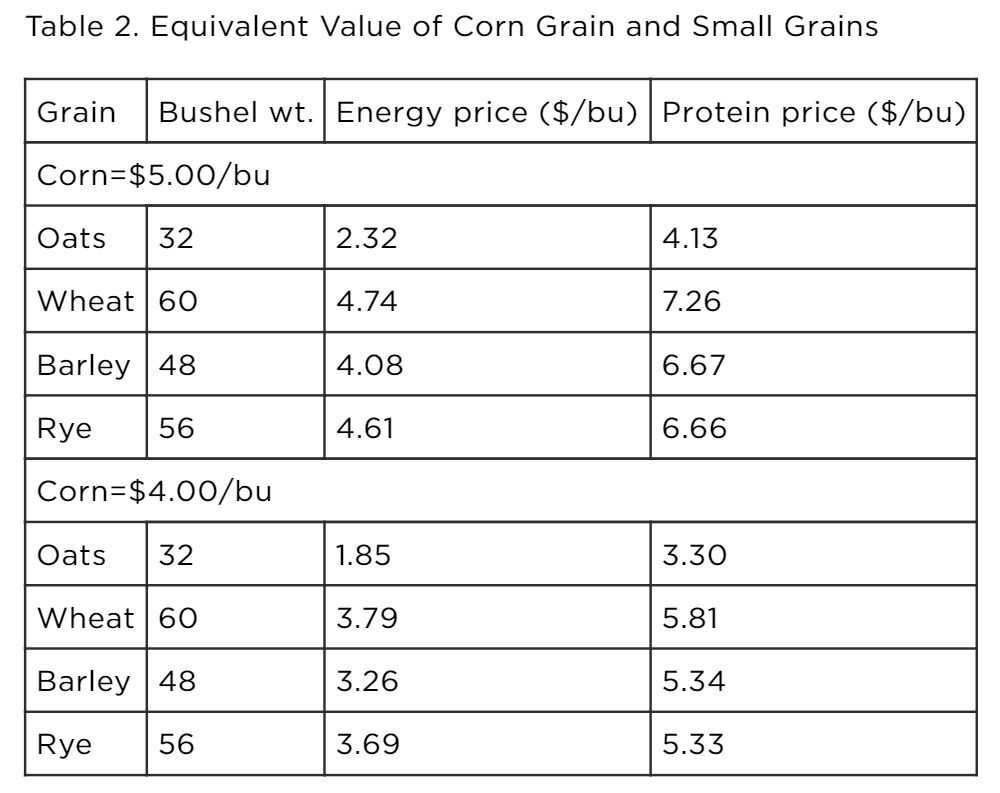Feeding Small Grains to Beef Cattle, Penn State Extension
Amy Barkley, Team Leader & Livestock Specialist
Southwest New York Dairy, Livestock and Field Crops Program
Prepared by Dr. John Comerford, retired Penn State professor
Authored by Daniel M. Kniffen and John W. Comerford
Cattle feeders for all classes of cattle are encountering corn prices that are at or near record levels. Alternative feeds may provide an alternative feedstuff and in many cases will make financial sense as an ingredient in the ration. One of the options is the use of small grains.
Price and Value:
The first issue to consider for replacing corn with small grains is how to make an equivalent exchange for both feed value and price. The following table describes the protein and energy value of some selected small grains as compared to corn.


These data show small grains will usually be a lower cost of protein as compared to corn, but, for most classes of beef cattle, protein will be a small or non- limiting nutrient. The most limiting nutrient will be energy, so the feeder should focus on the equivalent value of small grains as a source of energy and compare prices based on this feature.
Oats:
Oats are generally lower in energy and have more fiber content than other small grains. The hull of the oats will represent 24-30 % of the weight of the grain (John and Boyles, North Dakota State University.) Thus, their value as a source of energy in high-grain diets will be limited. Because of the high fiber content coupled with a relatively high energy value, oats are most effectively used with younger cattle to transition them to a grain diet. This can include using oats as a creep feed for nursing calves. Feeding programs for club calves and junior steer projects will often include oats as a means of adding energy to the diet with a lower potential for bloat and acidosis as compared to corn-based diets, although weight gain will be reduced. Oats may be processed by rolling or crimping and processing can add 5% efficiency to their use by the animal. However, this improved efficiency may not be enough to offset the cost of processing. Oats are usually not effective in a finishing diet because the energy value is lower, the total intake of feed may be reduced, and the cost may be prohibitive. As shown in Table 2 corn will be a cheaper source of energy than oats when corn is priced at $4.00/bu and oats are more than $1.85/bu.
Wheat:
Wheat provides a highly-degradable, high starch source of energy for the ruminant. Both the energy and protein content is often higher than in corn. However, wheat cannot totally replace corn as the energy component of the diet because of a higher incidence of acidosis and founder. Therefore, as a general rule wheat should not replace more than 50% of the corn in the diet, particularly for feedlot steers.
Because of the high degradability of wheat energy, cattle should be switched to wheat rations slowly to allow adaptation by the rumen. It should take up to 2 weeks to shift feedlot cattle for corn to high-wheat diets. The fiber level of wheat is also low (about 3%), so the fiber content of the ration would need to be adjusted to keep it at least 6% in the total ration. Wheat should be coarsely ground or rolled to prevent fines. Wheat should never be fed as a finely-ground product because in will greatly increase the potential for acidosis and bloat. Generally, wheat should not be used in starter diets for young cattle or for replacement heifers.
Wheat harvested late and (or) in wet conditions may be sprouted. Several studies have shown sprouted wheat will be as good as, and sometimes better than, unsprouted wheat as cattle feed. An Idaho study showed a diet that contained 60% sprouted wheat (with up to 36% sprouted kernels) resulted in similar cattle performance and feed efficiency in feedlot steers.
Similarly, rye can be used in cattle diets using the same considerations as wheat since the grain formation will be similar. There will usually be less energy and protein in rye compared to wheat, so the total amount available in the diet for cattle may be less. Additionally rye is less palatable than wheat therefore it should be limited in the ration as it may reduce intake.
Barley:
There may be some differences in animal performance in barley varieties for cattle fed limited diets containing barley. However, for feedlot cattle, no differences by variety would be expected. Additionally, there are mixed results for feeding low test-weight barley. In most cases, barley above 45.7 lbs/bu (Mathison et al., 1991) will perform similarly in feedlot diets. In general processing will increase the efficiency of use for barley compared to the whole grain. Barley can be ground or rolled, but, like wheat, should never be finely ground. There is a relatively high starch content of barley which implies fiber content of the diet should remain at 6% or higher, there should be no fines, and the diet should be introduced slowly to allow the rumen to adjust to the starch content. Acidosis and bloat are two symptoms of fines or non-adjustment. Barley has been used successfully as part of growing diets that include dry hay for up to 0.25% of total intake. In feedlot diets, barley has been used successfully to substitute for up to 2/3 of the corn in finishing diets, which is higher than that for wheat because the fiber content is higher and the starch content is slightly lower. Barley is generally the most flexible small grain substitute for corn provided price is compared and feeding standards are met.
Upcoming Events
Boots in the Barn: Cornell Dairy Research Updates
January 13, 2026
January 20, 2026
January 27, 2026
February 3, 2026
February 10, 2026
February 17, 2026
February 24, 2026
Join us for some or all!
Advanced Hoof Health Program
January 15, 2026
Belfast, NY
Who should attend?
- Professional hoof trimmers
- Dairy farm owners or managers in charge of farm foot health
Topics include:
- How to Create a Strategic Trimming Program for your Dairy
- The Latest in Lameness Technology for the Dairy Industry
- Housing and Flooring Design: Its Role in Hoof Care
NY Pork Producers Connection Breakfast - Geneseo
January 17, 2026 : Pork Producers Connection Breakfast - Geneseo
Geneseo, NY
All pork producers are invited to join the New York Pork Producers for a free hot farmer's breakfast, at which they'll catch up on topics including the pork to dairy barn conversion series, NYPP digital campaigns, and 840-RFID tags.
Announcements
No announcements at this time.





